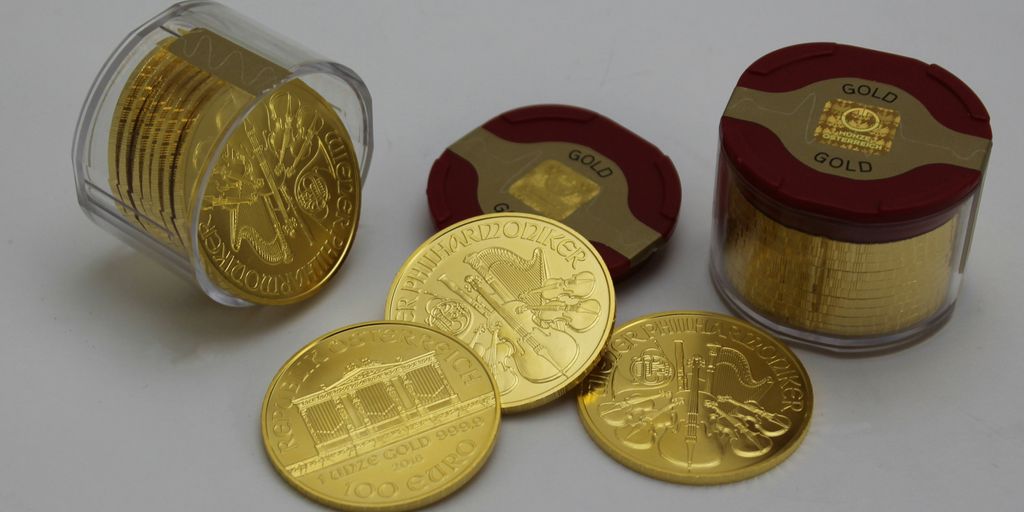Business
A Comprehensive Guide on How to Invest in Gold for Beginners

Gold has always been a popular investment choice for those looking to safeguard their wealth and diversify their portfolios. If you’re curious about how to invest in gold, you’re in the right place. This guide breaks down the basics, from the different ways you can invest to the risks and rewards involved. Whether you want to buy physical gold or explore other options, we’ve got you covered.
Key Takeaways
- Investing in physical gold includes bars and coins, which can be a tangible asset.
- Gold ETFs and mutual funds provide a way to invest in gold without holding the physical metal.
- Gold mining stocks can offer exposure to gold prices through company performance.
- It’s important to evaluate gold prices and market trends before investing, including understanding spot prices.
- Diversifying your portfolio with gold can help protect against market volatility.
Understanding Different Types of Gold Investments

So, you’re thinking about putting some money into gold? Smart move! But before you jump in, it’s good to know there’s more than one way to do it. You aren’t just stuck with gold bars like in the movies. Let’s break down the main options:
Physical Gold: Bars and Coins
This is the classic way to invest. You actually own the gold, which can be pretty cool. Gold bars gold bars are usually the most straightforward way to buy gold based on weight and purity. You can get them in different sizes, from tiny little gram bars to huge kilogram blocks. The price is usually pretty close to the spot price of gold, which is nice. Gold coins, like American Eagles, are another option. They have some historical or collectible value on top of the gold content, which can make them interesting. Some people also like gold ingots because they can have fancy designs.
Gold ETFs and Mutual Funds
If you don’t want to deal with storing physical gold, you can invest in gold exchange-traded funds (ETFs) or mutual funds. These funds invest in gold or gold mining companies. Gold ETFs gold ETFs are like stocks; you can buy and sell them on the stock market. They track the price of gold, so when the price of gold goes up, the value of your ETF shares goes up too. Mutual funds are similar, but they’re managed by a fund manager who decides which gold-related assets to invest in. This can be a good way to get exposure to gold without the hassle of owning the metal yourself.
Gold Mining Stocks
Another way to invest in gold is by buying stock in companies that mine gold. When the price of gold goes up, these companies usually make more money, so their stock prices can go up too. But it’s not a direct relationship. Gold mining stocks gold mining stocks are also affected by how well the company is managed, their mining costs, and other factors. So, it’s a bit riskier than owning physical gold or investing in a gold ETF, but it can also offer higher potential returns. You really need to do your homework and research the specific companies before you invest.
How to Start Investing in Gold

Okay, so you’re thinking about getting into gold investing? It’s not as complicated as it might seem. The main thing is to figure out what you want to get out of it and then pick the right way to invest. Let’s break it down.
Setting Your Investment Goals
First off, ask yourself: why gold? Are you trying to protect your money from inflation? Looking for a safe haven asset during uncertain times? Or do you just think gold prices will go up? Knowing your goals is super important because it will shape how much you invest and what kind of gold investment you choose. If you’re just trying to diversify, maybe a small percentage of your portfolio in gold is enough. But if you’re worried about a major economic downturn, you might want to put more in.
Choosing the Right Investment Method
There are a few ways to get into gold, and each has its pros and cons:
- Physical Gold (Bars and Coins): This is the classic way. You actually own the gold. The downside? You have to store it safely and insure it. Plus, when you sell, you might not get as much as you hoped because of dealer markups.
- Gold ETFs (Exchange-Traded Funds): These are like stocks that track the price of gold. They’re easy to buy and sell, and you don’t have to worry about storage. But you don’t actually own any gold – you just own shares in a fund that does.
- Gold Mining Stocks: This is where you invest in companies that mine gold. If the company does well, your stock goes up. But it’s riskier than owning gold directly because the company could have problems even if gold prices are high. You can add diversity to your portfolio by investing in gold mining stocks.
Finding a Reputable Dealer
If you decide to buy physical gold, do your homework. Not all dealers are created equal. Look for dealers with good reputations, transparent pricing, and clear return policies. Check online reviews and see if they’re members of any professional organizations. Don’t be afraid to shop around and compare prices. Also, be wary of deals that seem too good to be true – they probably are. Getting started with investing in the precious metal requires finding a dealer you can trust.
Evaluating Gold Prices and Market Trends
It’s super important to keep an eye on gold prices and what’s happening in the market if you’re thinking about investing. It’s not just about picking a random number; it’s about understanding what makes gold tick.
Understanding Spot Price and Premiums
Okay, so the spot price is basically the current market price of gold for immediate delivery. You’ll see this number thrown around a lot. But here’s the thing: you almost never actually pay just the spot price. There’s always a premium on top of that. This premium covers things like the cost of manufacturing coins or bars, the dealer’s profit, and other expenses. Premiums can vary a lot depending on where you’re buying from and what form of gold you’re getting. For example, a fancy, limited-edition gold coin will probably have a much higher premium than a plain gold bar. Keep an eye on those premiums because they can eat into your returns, especially if you’re planning to sell relatively soon after buying.
Analyzing Historical Gold Prices
Looking at how gold prices have moved in the past can give you some clues about potential future movements. It’s not a crystal ball, of course, but it can help you spot trends and understand how gold reacts to different events. You can find historical data all over the internet. Check out charts that show gold prices over the last few years, or even decades. See how it performed during recessions, periods of inflation, and times of political uncertainty. For example, gold often does well when the stock market isn’t doing so hot, because people see it as a safe haven. But remember, past performance doesn’t guarantee future results. The market is always changing.
Factors Influencing Gold Prices
Lots of things can push gold prices up or down. Here are a few big ones:
- Inflation: Gold is often seen as a hedge against inflation. When the cost of living goes up, people sometimes flock to gold, driving up its price.
- Interest Rates: Higher interest rates can sometimes make gold less attractive because other investments, like bonds, become more appealing. The Fed’s rate hikes and gold prices are often inversely related.
- Geopolitical Uncertainty: Wars, political instability, and other global crises can send investors running to gold as a safe place to park their money. For example, new tariffs can cause stock market volatility.
- Currency Fluctuations: The value of the dollar can affect gold prices. A weaker dollar often makes gold more attractive to investors holding other currencies.
- Supply and Demand: Basic economics! If there’s more demand for gold than there is supply, the price will likely go up. Factors like mine production and central bank buying can affect supply.
Staying informed about these factors can help you make smarter decisions about when to buy or sell gold. It’s a bit like being a detective, piecing together clues to figure out what might happen next. Remember that gold is a long-term investment.
Benefits of Investing in Gold
Okay, so why even bother with gold? It’s not like it pays dividends or anything. Well, there are actually some pretty solid reasons why people put their money into it. Let’s break it down.
Hedge Against Inflation
One of the biggest draws of gold is that it’s often seen as a hedge against inflation. Basically, when the cost of living goes up, gold tends to hold its value, or even increase. This is because gold is a tangible asset, and its value isn’t tied to any particular government or currency. Think of it as a way to protect your purchasing power when the dollar starts to weaken. It’s not a perfect system, but historically, gold has done a decent job of keeping up with inflation. You can also look into high yield savings accounts to protect your savings.
Portfolio Diversification
Don’t put all your eggs in one basket, right? That’s where diversification comes in. Gold can be a good way to diversify your investment portfolio because it doesn’t always move in the same direction as stocks and bonds. In fact, it often moves in the opposite direction. So, if your stocks are tanking, your gold investments might help cushion the blow. It’s all about spreading your risk around. A diversified portfolio is a healthy portfolio. You can also consider precious metal investments.
Safe Haven Asset
When things get really crazy in the world – like during a financial crisis or a major geopolitical event – people often flock to gold. It’s considered a "safe haven" asset because it tends to hold its value during times of uncertainty. People see it as a store of value that will be there no matter what happens. It’s like a financial security blanket. During a recession, gold can be a good investment.
Risks Associated with Gold Investments
Okay, so gold seems like a shiny, safe bet, right? But before you go all in, let’s talk about the downsides. It’s not all sunshine and bullion. There are definitely risks you need to consider before adding gold to your investment mix.
Market Volatility
Gold prices can jump around a lot. One day they’re up, the next they’re down. This volatility can be nerve-wracking, especially if you’re new to investing. It’s not like a savings account where you know exactly what you’re going to get. External factors can influence gold prices significantly. You’ve got to be prepared for those ups and downs and not panic sell when things get a little rocky. Think of it like a rollercoaster – exciting, but you need a strong stomach.
Storage and Insurance Costs
If you’re buying physical gold – bars, coins, jewelry – you’ve got to store it somewhere safe. Sticking it under your mattress isn’t the best idea. You’re looking at:
- Safety Deposit Boxes: Banks charge fees for these, and they’re not always the most convenient.
- Home Safes: You’ll need a good quality safe, which is an upfront cost, plus the risk of someone finding it.
- Professional Storage: Companies that specialize in storing precious metals will charge you a percentage of the gold’s value, usually annually. It can add up.
And then there’s insurance. You’ll want to insure your gold against theft, damage, or loss. That’s another ongoing expense to factor in. It’s not just about buying the gold; it’s about protecting it, which costs money.
Liquidity Concerns
Selling gold isn’t always as easy as selling a stock. Finding a buyer at the price you want can take time.
- Finding a Reputable Dealer: You need to find someone trustworthy who will give you a fair price.
- Shipping and Handling: If you’re selling physical gold online, you’ve got to deal with shipping, which can be risky and expensive.
- Market Demand: If there’s not much demand for gold when you want to sell, you might have to lower your price to attract buyers.
Unlike stocks, where you can often sell with a click, physical gold can be a bit more of a hassle. It’s not the most liquid asset out there, so keep that in mind if you might need quick access to your cash.
Tax Implications of Gold Investments
Alright, let’s talk taxes – because nobody likes surprises when it comes to Uncle Sam. Investing in gold isn’t just about buying and holding; you also need to understand how the IRS views your shiny new assets. It can get a little complicated, but we’ll break it down.
Capital Gains Tax
When you sell your gold for a profit, that profit is generally subject to capital gains tax. The rate you pay depends on how long you held the gold. If you held it for less than a year, it’s taxed as a short-term capital gain, which is the same as your ordinary income tax rate. If you held it for longer than a year, it’s taxed at the long-term capital gains rate, which is usually lower. However, gold and other collectibles have a maximum long-term capital gains rate of 28%. So, even if your regular long-term capital gains rate is lower, you’ll still pay up to 28% on your gold profits. This is why it’s important to keep good records of when you bought and sold your gold, and at what price.
Reporting Requirements
Any time you sell gold for a profit, you’re required to report it on your tax return. You’ll need to fill out Schedule D (Capital Gains and Losses) and Form 8949 (Sales and Other Dispositions of Capital Assets). The IRS requires you to report the date you acquired the gold, the date you sold it, the amount you sold it for, and your original cost basis. If you don’t report these transactions, you could face penalties. Also, be aware that if you sell a large amount of gold (over $10,000 in a single transaction), the dealer is required to report the sale to the IRS on Form 1099-B. So, the IRS will likely know about your sale anyway. It’s always best to be upfront and honest about your reporting requirements.
Tax-Advantaged Accounts
Here’s a little trick: you can hold gold in some tax-advantaged accounts, like a self-directed IRA. However, there are some pretty strict rules. The gold has to be held by a custodian, and it has to meet certain purity standards. You can’t just stash a bunch of gold coins in your regular IRA. The benefit of holding gold in a tax-advantaged account is that any profits you make are either tax-deferred (in a traditional IRA) or tax-free (in a Roth IRA). This can be a great way to grow your gold investments without having to worry about paying taxes every year. Just make sure you understand the rules and regulations before you try to buy gold online in an IRA, because the IRS doesn’t mess around.
Long-Term Strategies for Gold Investment
Dollar-Cost Averaging
Okay, so you’re thinking about gold for the long haul? Smart move. One strategy that people use is dollar-cost averaging. Basically, instead of throwing all your money into gold at once, you spread it out. You buy a fixed dollar amount of gold at regular intervals – like every month or every quarter. This way, you’re buying more gold when prices are low and less when prices are high. It smooths out the ups and downs, so you don’t kick yourself if you buy a bunch right before a dip. It’s a pretty chill way to invest, especially if you’re not trying to time the market.
Rebalancing Your Portfolio
Think of your investment portfolio like a balanced diet. You need a mix of stuff to stay healthy. Gold can be part of that mix, but you don’t want it to take over. Rebalancing means periodically adjusting your portfolio to maintain your original asset allocation. Let’s say you initially allocated 10% of your portfolio to gold. If gold prices go up, that allocation might creep up to 15%. Rebalancing involves selling some of your gold to bring it back down to 10% and using that money to buy other assets. This helps you maintain your investment strategy and take profits along the way. It’s like trimming a hedge to keep it in shape.
Staying Informed on Market Changes
Investing in gold isn’t a "set it and forget it" kind of deal. You need to keep an eye on what’s happening in the world. Economic news, inflation reports, interest rate decisions – all of these things can affect gold prices. I usually check a few reliable financial news sites a couple of times a week. You don’t have to become an expert, but knowing the basics can help you make better decisions. Plus, understanding historical gold prices can give you some perspective on where things might be headed. It’s like reading the weather forecast before planning a picnic – you want to be prepared for anything.
Wrapping It Up
So, there you have it! Investing in gold can be a smart move for your portfolio, especially if you’re looking to add some stability. Whether you choose physical gold, ETFs, or mining stocks, each option has its own benefits and risks. Just remember to do your homework and think about what fits best with your financial goals. Gold isn’t a quick way to get rich, but it can help protect your wealth over time. If you’re ready to take the plunge, start small and learn as you go. Happy investing!
Frequently Asked Questions
What types of gold can I invest in?
You can invest in physical gold like coins and bars, gold ETFs, mutual funds, or gold mining stocks.
How do I start investing in gold?
Begin by deciding your investment goals, choose how you want to invest, and find a trustworthy dealer.
What affects the price of gold?
Gold prices can change based on supply and demand, economic conditions, and global events.
Is investing in gold safe?
While gold is generally considered a safe investment, it can still be affected by market changes and may not always increase in value.
Do I have to pay taxes on gold investments?
Yes, profits from selling gold may be subject to capital gains tax, so it’s important to keep records.
What is the best way to invest in gold for beginners?
Begin with gold ETFs or mutual funds as they are easier to manage and require less initial investment.
-

 Home and Garden3 days ago
Home and Garden3 days agoTransform Your Space: A Guide to Minimalist House Interior Design in 2025
-

 Home & Family3 days ago
Home & Family3 days ago10 Essential Cleaning Hacks for Bathroom Surfaces You Need to Try
-

 Innovations5 days ago
Innovations5 days agoWill AI Take Your Job? The Truth About Automation and Employment
-

 Press Release7 days ago
Press Release7 days agoWhat Makes Alaxio Different from Every Other Altcoin?
-

 Crime3 days ago
Crime3 days agoExploring the Most Anticipated New True Crime Documentaries of 2025
-

 Health & Fitness2 days ago
Health & Fitness2 days agoDiscover the Best Multivitamin for Women Over 40: A Comprehensive Guide to Optimal Health
-

 Business3 days ago
Business3 days agoMaximize Your Earnings with American Express High Yield Savings Accounts in 2025
-

 Health & Fitness3 days ago
Health & Fitness3 days agoDiscovering the Best Multivitamin for Women Over 40: Essential Nutrients for Optimal Health


















